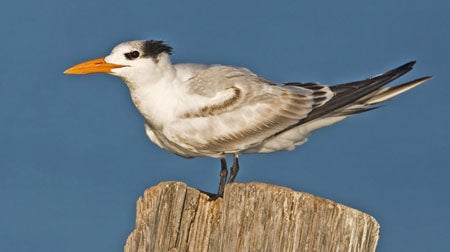SCIENTIFIC NAME:
Thalasseus maxima
STATUS:
Breeder. Common in all seasons in Gulf Coast region. Occasional in fall after storms inland, mostly in Mountain and Inland Coastal Plain regions.
DESCRIPTION:
A large tern only exceeded in size by the Caspian tern. Adults are approximately 19 inches long with a wingspan of around 50 inches. Royal terns weigh from three-quarters to almost one pound. Breeding adults are white underneath with pale gray upperparts. Trailing edge of primary wing feathers is dark on the upper side. The head is topped with a black cap and crest. As the nesting season progresses, the forehead becomes more white and remains so through the non-breeding season. Royal terns have an orange bill and black legs. Immature birds retain a white forehead and have more brownish and darker wing feathers. The bill in young birds is more yellowish.
DISTRIBUTION:
In the United States, royal terns nest along the Atlantic coast from Virginia to Florida and along the entire Gulf Coast. Birds nest irregularly along the southern California coastline of the Pacific Ocean. Outside of the United States, birds are found on both coasts of Mexico and in the Caribbean with breeding occurring sporadically. Winter range overlaps much of the breeding range and extends south into South America. Royal terns are also found on the western side of Africa.
HABITAT:
They inhabit oceanic coastal habitats including the Gulf, beaches, and coastal bays.
FEEDING HABITS:
Their diet consists primarily of fish, but crustaceans, mainly shrimp, are also eaten. Birds capture food by diving from heights up to approximately 30 feet. A variety of prey is taken as birds opportunistically take whatever is available at the moment.
LIFE HISTORY AND ECOLOGY:
Royal terns nest on barrier islands or on isolated coastal beaches. In Alabama nesting occurs annually on Gaillard Island, a dredge disposal island in Mobile Bay. Nesting has also occurred on the undeveloped western end of Dauphin Island and on Cat Island in the Mississippi sound. Birds nest on the ground, free of any vegetation. The nest is a simple scrape in the substrate where normally only one egg is laid. Eggs have also been observed laid on the ground with no evidence of any nest scrape. Birds nest in dense colonies that can number in the thousands. Nests (eggs) are placed within twelve inches of each other and on Gaillard Island a colony of 2,000 nests is common. On average, 1,500 to over 3,000 royal terns nest in Alabama with the vast majority of birds nesting on Gaillard Island.
After an incubation of 25 to 30 days, chicks hatch with down feathers and are mobile only hours after hatching. Chicks will remain at the nest for up to a week unless disturbed. By two weeks of age, most young gather together in a large mobile group known as a crèche. Though appearing nearly identical, eggs and young are identified by parents who share incubation and chick feeding duties. At approximately one month of age, young royal terns fledge. Birds may not begin nesting until four years of age.
REFERENCES:
Buckley, P. A., and F. G. Buckley. 2002. Royal Tern (Sterna maxima). In The Birds of North America, No. 700 (A. Poole and F. Gill, eds.). The Birds of North America, Inc., Philadelphia, PA.
Malling Olsen, K., and H. Larsson. 1995. Terns of Europe and North America. Christopher Helm, London, U.K.
AUTHOR:
Roger Clay, Wildlife Biologist, Division of Wildlife and Freshwater Fisheries






